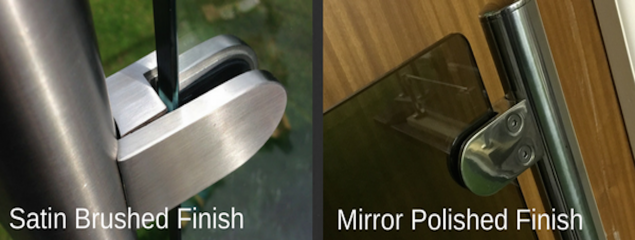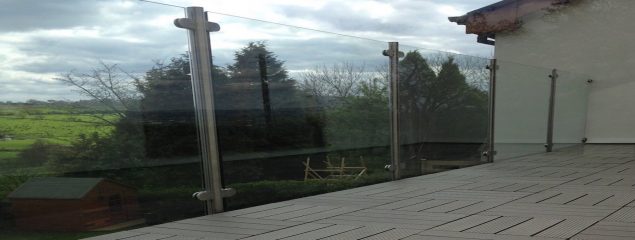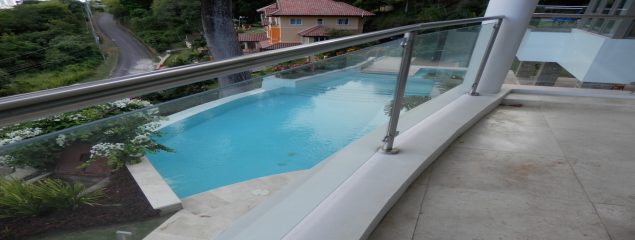Mirror Polished Vs Satin Brushed Stainless Steel Components for Exterior Balustrades
Exterior balustrades have become increasingly popular in modern architecture. They provide an essential safety feature for the increasing numbers of people who want to enjoy their outdoor spaces more, whether this be for dining, socialising, relaxing, or spending much valued family time. Polished Vs Satin Brushed stainless steel is not always about the look but regards its use and environment it is subjected too.
Stainless steel and glass exterior balustrades not only provide a safety solution but also add an elegant and sophisticated finishing touch to any garden, patio, or terrace. The functional benefit of safety combined with visual aesthetics that add to the beauty of any building make stainless steel and glass exterior balustrades a worthwhile investment. Outdoor living is often considered a top design priority for buyers and agents within the property market so there may be increased interest in your property and higher valuations at a time you do want to sell. However, it is important that you choose the correct stainless steel finish for your own requirements and the environment where the balustrade will be installed. Here we will discuss the similarities and differences between mirror polished and satin brushed stainless steel finishes to help you choose the best possible design for your balustrade.
The differences between mirror polished vs satin brushed stainless steel
An important note to make is the type of Polished Vs Satin Brushed you choose does not affect the grade of stainless steel. Most of our exterior balustrades are manufactured using superior grade 316 stainless steel making them suitable for external use. Our Mini-Post frameless glass balustrades offer further corrosion resistance, especially in coastal locations since they are manufactured with Marine Grade 2205 Duplex stainless steel. However, there are differences in the manufacturing processes that create satin and mirror polished finishes which not only produce your preferred look, but also make one or the other more suitable for other considerations. This will be discussed further below.
The manufacturing process of satin and mirror polished stainless steel
The satin finish is achieved by sanding the stainless steel in one direction using a grit belt followed by a softening and buffing process which creates a less shiny but glossy look. Some consider this to be more suited to architectural projects where overall look is the most important factor as any wear and tear may not be as visible and many people prefer not to have too much reflectiveness. However, it is important to realise that some level of variation should be expected with a satin finish due to the manufacturing process which also makes a satin finish more susceptible to corrosion in coastal locations due to salt particles in the air. High humidity areas such as around swimming pools are also not suited to satin finish stainless steel and glass exterior balustrades because the grooves of the finish present increased risk of rust.
If exterior balustrades are required in a coastal location or high chloride area, we recommend our Marine Grade 2205 duplex Mini-Post frameless balustrade system. However, if a framed design is preferred, our mirror polished Marine Grade 316 stainless steel balustrade components would also provide superior corrosion resistance. Stainless steel and glass exterior balustrades with a mirror polished finish have a finer brushing and longer buffing process in manufacturing whereby a highly reflective surface is created. Whilst this shiny surface is undesirable by some, it is of main aesthetic appeal to others. Furthermore, the smoother finish enables easier maintenance and cleaning as there are no tiny crevices where dirt can become trapped.
What is grade 2205 – Duplex Stainless Steel? and does this need to be in a mirror polish or satin brushed finish?
Duplex stainless steels are becoming more common and can come in different finishes just as with 304 or 316 stainless for similar reasons. So how to choose Polished vs Satin Polished finish with duplex stainless is often lead by atheistic look rather than environmental use. Duplex stainless is being offered by businesses like ourselves for a number of reasons:
Higher strength leading to weight saving
Greater corrosion resistance particularly stress corrosion cracking
Better price stability
Lower price
Principle of Duplex Stainless Steels
The idea of duplex stainless steels dates back to the 1920s with the first cast being made at Avesta in Sweden in 1930. However, it is only in the last 30 years that duplex steels have begun to “take off” in a significant way. This is mainly due to advances in steelmaking techniques particularly with respect to control of nitrogen content.
The standard austenitic steels like 304, (1.4301), and ferritic steels like 430 are relatively easy to make and to fabricate. As their names imply, they consist mainly of one phase, austenite or ferrite. Although these types are fine for a wide range of applications, there are some important technical weaknesses in both types:
To sum up, your choice in a satin or mirror polished finish for your stainless steel and glass exterior balustrade will depend on your personal preferences and individual circumstances for installation. Despite this, the several benefits of using stainless steel in your design will remain the same either way.
If you would like more information or advice in taking the next step to having your perfect balcony, patio, or terrace area, call one of our friendly team members on 01254 825594.
Alternatively, drop us an email with your requirements at sales@elitebalustrade.com . We look forward to being of assistance.
Published: 9th May 2017






